Abstract
Idiopathic gingival enlargement is a proliferative fibrous lesion of the gingival tissue that causes esthetic and functional problems. Both genetically and pharmacologically induced forms of gingival enlargement exist. This case report addresses the diagnosis and treatment of a case of idiopathic gingival enlargement in a 13-year-old female. The patient presented with generalized diffuse gingival enlargement involving the maxillary and mandibular arches extending on buccal and lingual/palatal surfaces and covering incisal / occlusal third of the tooth resulting in difficulty in speech and mastication since last three years. Patient also gave a history of surgical treatment being carried out four years back in upper anterior region suggesting of recurrence. Biopsy report confirmed the diagnosis of gingival hyperplasia. Gingivectomy was carried out in all four quadrants by using four different methods.
Keywords: Gingival enlargement, gingival fibromatosis, gingivectomy
INTRODUCTION
Gingival fibromatosis (GF) is a heterogeneous group of disorders characterized by progressive enlargement of the gingiva caused by an increase in submucosal connective tissue elements. Many cases are iatrogenic; some are inherited while others are idiopathic.[1] The etiology and pathogenesis of gingival hyperplasia are still not well established, however it could be directly linked to three factors: individual susceptibility, local factors (dental plaque, caries, and iatrogenic factors) and the action of chemical substances and their metabolites. The condition is not painful until the tissue enlarges to partially cover the occlusal surface and becomes traumatized during mastication. Due to massive gingival enlargement, an affected child usually develops an abnormal swallowing pattern and experiences difficulty with speech and mastication. Along with these features, there may be some interference with maintenance of oral hygiene and mastication. All these factors will favor accumulation of materia alba and plaque, which further complicates the existing hyperplastic tissue.[2] Acute pain associated with gingival hyperplasia leads to loss of masticatory ability and difficulty in swallowing food. Therefore, these patients have a tendency to swallow partially crushed food which eventually causes gastric disturbances.[2] The number of patients with this oral lesion have greatly increased in the last three decades. Hereditary GF (HGF) is a rare disease, affecting only one in 750,000 people[1] while it can develop as an isolated disorder or a feature of a syndrome. HGF is most commonly associated with hypertrichosis[3] and associated with mental retardation and epilepsy. Unlike in HGF and iatrogenic GF, in idiopathic GF (IGF), no causative agent can be identified and a family history is always lacking. We report a non-syndromic case of GF along with its management.
CASE REPORT
A 13-year-old female patient reported to the Department of Periodontics with a chief complaint of swollen gums involving all her teeth since last three years preventing proper speech, articulation, and mastication, causing inadequate lip apposition and poor esthetics. Four years earlier, she was operated for the enlargement by a private practitioner. She did not give any history of drugs intake, fever, anorexia, weight loss, seizures, hearing loss, nor was having any physical or mental disorder. Also familial and postnatal history was non-contributory.
Examination
Extra-oral examination revealed that the patient has incompetent everted lips and a convex profile. An intraoral examination revealed generalized, diffused, nodular enlargement of the gingiva involving the upper and lower arches, which were pink in color, and had a firm and fibrous consistency [Figure 1]. The teeth were barely visible as the enlarged gingiva covered till the incisal/occlusal third of the teeth. Grade I mobility was seen in lower incisors.
Figure 1.
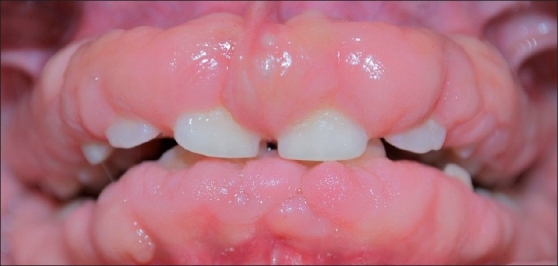
Pre-operative
Investigations
Intraoral periapical and panoramic radiograph revealed no bone loss [Figure 2]. Over-retained deciduous teeth 53 and 74 were present. Hematological investigations were within normal limits. Punch biopsy was carried out which revealed bulbous increase in the connective tissue, which was relatively avascular and had densely arranged collagen-fiber bundles, numerous fibroblasts, and mild chronic inflammatory cells. The overlying epithelium exhibited hyperplasia and had elongated rete ridges suggesting histological diagnosis of fibroepithelial hyperplasia.
Figure 2.

OPG
Diagnosis
On the basis of medical, family, drug history, clinical and histological findings, it was diagnosed as idiopathic gingival enlargement.
Treatment
After completion of Phase I treatment, a quadrant-wise gingivectomy was performed under local anesthesia using four different techniques. In first quadrant, ledge and wedge technique was performed [Figure 3] followed by external bevel gingivectomy in second quadrant after ten days [Figure 4]. Kirkland knives were used for incisions on the facial and lingual surfaces. Orban periodontal knives were used for interdental incisions. Ten days later, surgery using an electrocautery device with a medium size, loop electrode was performed in third quadrant [Figure 5]. A soft tissue diode laser was used for gingivectomy in the fourth quadrant [Figure 6]. Co-pack was given in all four quadrants to reduce patient discomfort. Use of laser and electrocautery provided excellent hemostasis and better immediate postoperative result. Also the patient acceptance towards the treatment was better with these two rather than the conventional approach [Figure 7].
Figure 3.
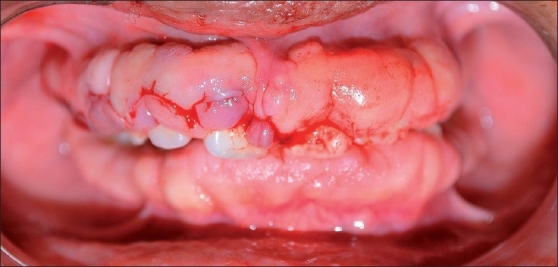
First quadrant - Ledge and Wedge technique
Figure 4.
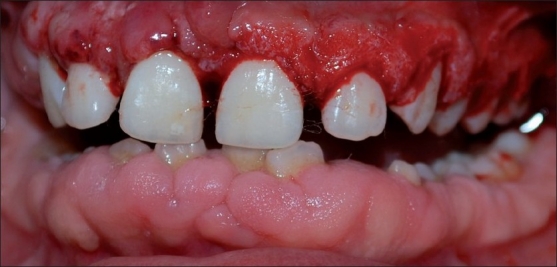
Second quadrant - External bevel gingivectomy
Figure 5.
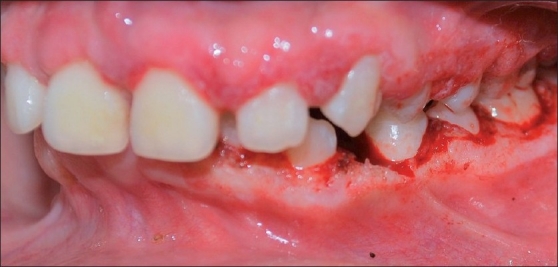
Third quadrant - Electrocautery
Figure 6.
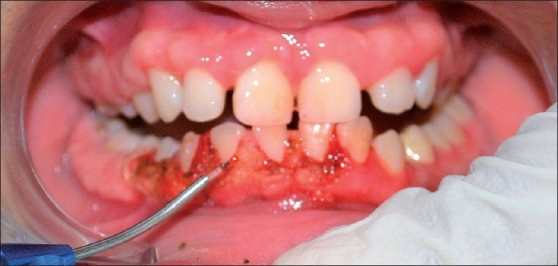
Fourth quadrant - Diode laser
Figure 7.
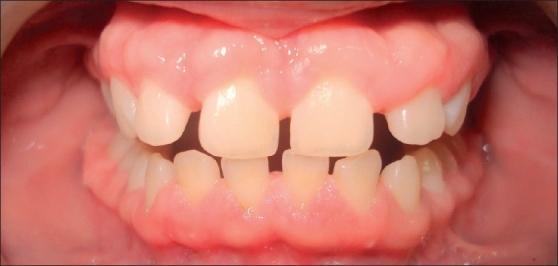
Postoperative
DISCUSSION
IGF may be congenital or hereditary. Though the genetic mechanism is not well understood, the majority of the reported cases have attributed the condition of fibrous enlargement of gingiva to hereditary factors. The mode of transmission is mainly autosomal dominant. The first polymorphic marker for HGF phenotype is chromosome 2p21.[4,5] Many cases are sporadic with no familial background.
Gingival hyperplasia can occur after therapy with drugs like phenytoin,[6] cyclosporine, nifedipine, and nitrendipine. Long-term use of these drugs has to be ruled out. The incidence of gingival enlargement caused by phenytoin, an anticonvulsant used in the treatment of epilepsy varies from 3−84.5%. Whereas, cyclosporine a fairly potent immunosuppressive agent, used to prevent organ transplant rejection and to treat several disease of autoimmune origin, induced gingival enlargement in 30% of the cases.[7] Nifedipine, which is a calcium channel blocker used in the treatment of acute and chronic coronary insufficiency, including angina pectoris and refractory hypertension and nitrendipine an analog of nifedipine have also been reported to induced gingival enlargement.[8,9]
Gingival hyperplasia may be associated with physical development, retardation, and hypertrichosis.[10] Although gingival tissue may appear normal at birth, hyperplastic GF may become evident with the eruption of primary or permanent dentition, suggesting a trauma-induced tissue reaction during the eruption.[11] Sometimes gingival enlargement does not occur until the eruption of the permanent dentition. Further enlargement does not occur once the growth of jaw is completed.[12] It has been suggested that gingival enlargement may be due to nutritional and hormonal factors; however, these have not been completely substantiated. The constant increase in the tissue mass can result in delayed eruption and displacement of teeth, arch deformity, spacing, and migration of teeth.[13] The condition is not painful until the tissue enlarges to partially cover the occlusal surface of the molars and become traumatized during mastication, which was observed in the present case. Due to massive gingival enlargement, an affected child usually develops abnormal swallowing pattern and experiences difficulty in speech and mastication. Along with these features, there may be some interference with the oral hygiene measures and normal mastication. All these will favor accumulation of materia alba and plaque, which further complicates the existing hyperplastic tissue. Maintenance of good oral hygiene is very important. It is not known if plaque control measures are effective in this condition; however, it is a good practice to maintain the plaque control following gingivectomy procedure.
Histologically, the gingival hyperplasia is mainly due to an increase and thickening of mature collagen bundles in the connective tissue stroma. The nodular appearance can be attributed to the thickened para hyperkeratinized epithelium. Various modalities of treatment had been proposed including radical treatment with extraction of the involved teeth, which was reported not to favor a recurrence of the growth. The only treatment of choice in this condition was gingivectomy to satisfy the patient's esthetics. Though the tissue appeared to be pale and firm, the surgical procedure was complicated with excessive hemorrhage. Since recurrence could be expected within a few months after surgery and may return to the original condition within few years, the patient may have to undergo repeated gingivectomy procedures. This often causes further increase in the patients′ and parents′ psychological and emotional stress. Hence, psychological counseling is a must for patients and parents.
CONCLUSION
Even though recurrence cannot be predicted, the psychological and functional benefits far outweigh the risk of recurrence. Oral hygiene and the superimposition of plaque accumulation have a crucial effect on the prognosis of GF. Long-term follow-up will be required to evaluate the predictability of the different surgical techniques.
Acknowledgments
The study was self-funded by the authors and their institution. No conflicts of interest.
Footnotes
Source of Support: Nil
Conflict of Interest: None
REFERENCES
- 1.Pappachan B, Narayan JV, Nayak A. Idiopathic gingival fibromatosis: A neglected case. Indian J Radiol Imaging. 2002;12:335–8. [Google Scholar]
- 2.Ramer M, Marrone J, Stahl B, Burakoff R. Hereditary gingival fibromatosis: Identification, treatment, control. J Am Dent Assoc. 1996;127:493–5. doi: 10.14219/jada.archive.1996.0242. [DOI] [PubMed] [Google Scholar]
- 3.Gorlin RJ, Cohen MM, Levin LS. New York: Oxford University Press; 1999. Syndromes of the head and neck. [Google Scholar]
- 4.Cortelli JR. Evidence of genetic heterogenecity for hereditary gingival fibromatosis. J Dent Res. 2000;79:1758–64. doi: 10.1177/00220345000790100501. [DOI] [PubMed] [Google Scholar]
- 5.Hart TC, Pallos D, Bowden DW, Bolyard J, Pettenati MJ, Cortelli JR. Linkage of hereditary gingival fibromatosis to chromosome 2~21. Am J Hum Genet. 1998;62:876–83. doi: 10.1086/301797. [DOI] [PMC free article] [PubMed] [Google Scholar]
- 6.Angelopoulos AP, Goaz PW. Incidence of diphenylhydantoin gingival hyperplasia. Oral Surg Oral Med Oral Pathol. 1972;34:898–906. doi: 10.1016/0030-4220(72)90228-9. [DOI] [PubMed] [Google Scholar]
- 7.Seymour RA, Smith DG, Rogers SR. Comparative effect of azathioprine and cyclosporine on some gingival health parameters of renal transplant patients.A longitudinal study. J Clin Periodontol. 1987;14:610–3. doi: 10.1111/j.1600-051x.1987.tb01524.x. [DOI] [PubMed] [Google Scholar]
- 8.Barclay S, Thomason JM, Idle JR, Seymour RA. Incidence and severity of nifedipine induced gingival overgrowth. J Clin Periodontol. 1992;19:311–4. doi: 10.1111/j.1600-051x.1992.tb00650.x. [DOI] [PubMed] [Google Scholar]
- 9.Brown RS, Sein P, Corio R, Bottomley WK. Nitrendipine-induced gingival hyperplasia.First case report. Oral Surg Oral Med Oral Pathol. 1990;70:593–6. doi: 10.1016/0030-4220(90)90406-i. [DOI] [PubMed] [Google Scholar]
- 10.Shafer WG, Hine MK, Levy BM. 4th ed. Philadelphia: A Prisma Indian; 1993. Developmental disturbances of the perioral structures. pp. 23–4. [Google Scholar]
- 11.Gupta N, Maheshwari S. Advanced gingival fibromatosis. J Indian Dent Assoc. 1996;167:46–7. [Google Scholar]
- 12.Stewart RE. USA: Mosby Company; 1982. Periodontal diseases in children.Pediatric Dentistry and Clinical Practice. [Google Scholar]
- 13.Mcdonald RE, Avery DR. Dentistry for the Child and Adolescent. 7th ed. USA: Mosby Company; 2000. Gingival and periodontal diseases. [Google Scholar]



